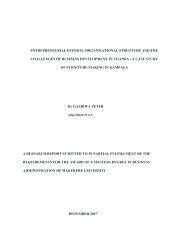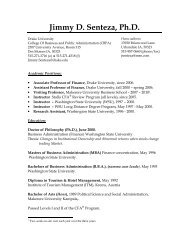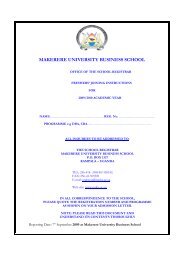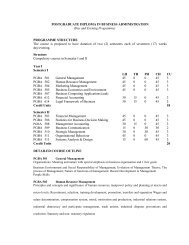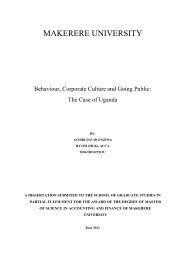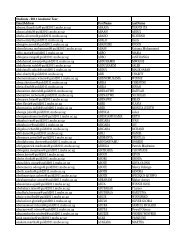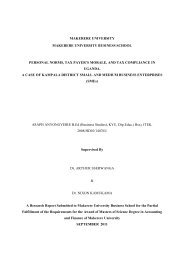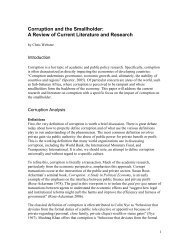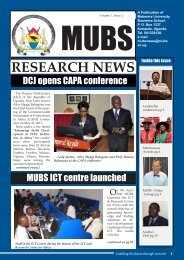13th Annual International Management Conference Proceeding
13th Annual International Management Conference Proceeding
13th Annual International Management Conference Proceeding
You also want an ePaper? Increase the reach of your titles
YUMPU automatically turns print PDFs into web optimized ePapers that Google loves.
esearch questions examined the participants’ perceptions regarding the environmental factors that seemed to influence<br />
the transfer of training. The research questions were:<br />
1. What work environment factors influence the transfer of training in agri-businesses?<br />
2. Is there a difference between the environment factors that influence transfer of training in agri-businesses and in<br />
other business organizations?<br />
3. What socio-economic changes in the agri-businesses can be attributed to training?<br />
Research Methodology<br />
The study used a qualitative research design. A fundamental characteristic of qualitative research is its in-depth<br />
exploration of a phenomenon and its context (Denzin & Lincoln, 1994; Fryer, 1991; Patton, 1990).<br />
Data was collected from the total population of thirty (30) participants – twelve (12) in Rift Valley Province and<br />
eighteen (18) in Central Province through semi-structured questionnaires, administered through personal interviews at<br />
their work places. To authenticate the results, data was triangulated through observations and document analysis.<br />
Data collection and analysis were simultaneous as a requirement for a qualitative study (Merriam, 1988; Marshall &<br />
Rossman, 1989). At the same time there was an identification of both the trainee and environment factors that seemed<br />
to influence transfer of training in an entrepreneurial context and the specific business performance improvements<br />
made as a result of the training, thus bringing out its role.<br />
Scope of the Study<br />
The study covered thirty (30) participants who had gone through a one-month enterprise development programme<br />
conducted by the African Institute for Capacity Development (AICAD). The participants were drawn from Rift<br />
Valley and Central Provinces of Kenya. In Rift Valley Province, the study covered two districts namely Narok and<br />
Nakuru while in Central Province; the districts covered were Thika and Kiambu. The study focused on the application<br />
of the KSAs acquired and changes in business performance arising thereof.<br />
Results and Analysis<br />
Generally, all the participants in both provinces were involved in a variety of farm and non-farm entrepreneurial<br />
activities such as crops, dairy, poultry; merchandizing; public transport and food processing.<br />
However in Rift Valley Province, the participants in Narok District were mainly farming onions and tomatoes as<br />
major crops; grown under irrigation served by permanent rivers (Osupuko and Kanunga areas) and a dam (Maji Moto<br />
area). Farming in Nakuru and Kiambu Districts was restricted to rain water, as the area is not served by any river.<br />
Participants in both Districts tended grade, high milk-yielding cows, while those in Narok District kept local<br />
traditional breeds except for one farmer who had both breeds. There were cases where some trainees had introduced<br />
new breeds revealing risk-taking propensity. One such case was noted in Nakuru District where one farmer had<br />
purchased a new hybrid sheep from Kenya Agricultural Research Institute (KARI) on a trial basis. He intended to<br />
increase the number if they proved successful so as to enhance milk production and income generation. Within the<br />
same province, there were notable differences in the entrepreneurial intensity among the participants. Though all the<br />
participants in both provinces were engaged in poultry farming, those in Narok District (Maasai community) were<br />
involved in small scale traditional poultry, mainly for domestic consumption, while those in Nakuru District (Kikuyu<br />
community) were engaged in large-scale poultry farming with one of them trying out a new breed, “Kenbrew” which<br />
he had acquired from Ken Chick Ltd. The same was true of the intensity and variety of entrepreneurial activities.<br />
Participants in Narok District engaged in common farm activities such as tomatoes, onions, maize and dairy on limited<br />
scale with no one in non-farm entrepreneurial activities unlike their counterparts in Nakuru and Kiambu Districts, who<br />
were involved in a number of farm and non-farm entrepreneurial activities. However, in both cases there were notable<br />
changes as a result of the training: In Narok District, participants had embraced crop farming which they never did<br />
before while in Nakuru and Kiambu districts, participants had introduced new varieties and diversified into new<br />
entrepreneurial activities such as merchandizing of agricultural inputs and processing which they never did before.<br />
95



